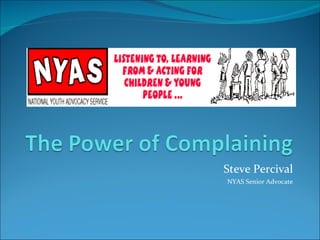Steve Percival - The Power of Complaining
•Télécharger en tant que PPT, PDF•
0 j'aime•689 vues
Steve Percival on "The Power of Complaining" at the 2010 CROA Conference in Manchester - www.croaconference.com
Signaler
Partager
Signaler
Partager

Recommandé
Contenu connexe
Tendances
Tendances (20)
Child sex abuse- an essay- giving a concern it deserves

Child sex abuse- an essay- giving a concern it deserves
Making a Difference WV Mandated Reporter Training Powerpoint - Updated April ...

Making a Difference WV Mandated Reporter Training Powerpoint - Updated April ...
En vedette
En vedette (20)
Handling an irate customer in a face to face situation

Handling an irate customer in a face to face situation
Similaire à Steve Percival - The Power of Complaining
Similaire à Steve Percival - The Power of Complaining (20)
School Teachers Child Safeguarding Training in South Sudan

School Teachers Child Safeguarding Training in South Sudan
Example of-child-protection-policy-for-voluntary-organisations

Example of-child-protection-policy-for-voluntary-organisations
New Jersey Division of Child Protection and Permanency v.T.docx

New Jersey Division of Child Protection and Permanency v.T.docx
SOWK 602 - Wk 5 - Group 2 - Social Work Law and Ethics California Standards T...

SOWK 602 - Wk 5 - Group 2 - Social Work Law and Ethics California Standards T...
Plus de CROA Not for profit
Plus de CROA Not for profit (10)
Children on rights and responsibilities…(Children's Rights Director for England)

Children on rights and responsibilities…(Children's Rights Director for England)
Wales: Benevolent land of advocacy and children’s rights? 

Wales: Benevolent land of advocacy and children’s rights?
Reasons to be cheerful? Advocacy and the new government 

Reasons to be cheerful? Advocacy and the new government
Steve Percival - The Power of Complaining
- 1. Steve Percival NYAS Senior Advocate
